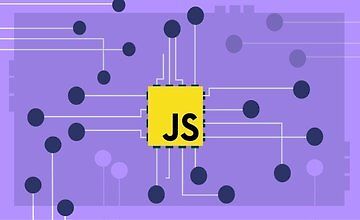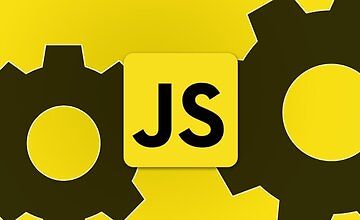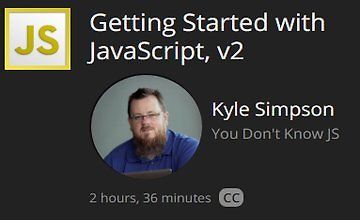
udemy
Udemy - одна из самых больших площадок в мире по доставке обучающего контента от разных авторов всего мира. Присутсвуют курсы практически на любую тему.
*NEW* JavaScript Complete Grandmaster 2020. Ongoing updates.
JavaScript - это язык № 1 в Интернете, где большая часть динамического и стилизованного контента обрабатывается JavaScript в фоновом режиме. Но прежде чем использовать этот язык для создания динамических веб-сайтов, вам необходимо четко понять, как он работает за кулисами.
К концу этого курса вы сможете «говорить» на JavaScript, приобретя понимание того, как браузер использует его, какие переменные, объекты и функции существуют, какие существуют типы данных и как манипулировать контентом на веб-сайте. , Мы копаем глубже и создаем наши собственные методы диалога с нуля. Мы узнаем о синтаксисе стрелок, функции Math.random (), прохождении по объектам и массивам, работе с датами. Мы смотрим на прототипы, JS движки, стек выполнения и многое другое!
На практических примерах этот курс поможет вам понять JavaScript по частям. Мы также используем самые последние и лучшие функции JavaScript, чтобы вы могли быть впереди всех.
*** Самый важный курс JavaScript на Udemy ***
Успешные программисты знают больше чем заучивание нескольких строк кода JavaScript. Они также знают основы того, как работает язык, его сильные и слабые стороны, и как машина использует то, что они пишут, для создания удивительных и функциональных веб-сайтов.
Я хочу, чтобы вы стали успешным гроссмейстером по программированию.
Я хочу, чтобы вы могли применять JavaScript на своей веб-странице.
Этот курс идеально подходит для вас.
Описание
Привет, меня зовут Клайд, и вместе мы собираемся открыть для себя JavaScript и применить его на практике. Мы собираемся практиковаться, учиться и проявлять уверенность, чтобы справиться с любыми проблемами, которые бросают на нас современные программы и веб-сайты.
После получения нескольких (не связанных) университетских степеней и обучения в аспирантуре я увлекся языками веб-дизайна и программного обеспечения. Я потратил немало времени на лучшие курсы и продолжил применять полученные знания на практике. Я распознал пробелы в некоторых курсах, которые я прошел, и, следовательно, мой курс учит тому, чему бы я хотел, чтобы меня учили. Мое намерение состоит в том, чтобы поделиться знаниями с вами в простой для понимания форме, чтобы мы могли извлечь выгоду вместе. Вы выигрываете от обучения, а я - от вашего успеха.
Этот курс для начинающих и мидл разработчиков. Если вы знаете основы, вы можете пропустить первые несколько разделов.
Копаем глубже
Вы не просто изучите несколько фрагментов кода, вы также изучите основы самого программирования. Это важно, так как все языки программирования построены на одном фундаменте. Изучение основных понятий JavaScript поможет вам стать программистом на любом языке.
Вы узнаете, «почему» все работает, а не просто «как». Понимание основ JavaScript очень важно, поскольку оно позволит вам писать более сложный код. И поверьте мне, каждое программирование сталкивается с ошибками, и без понимания основ вы будете полностью потеряны.
Практика делает совершенным
Теория есть теория ... но нет ничего лучше, чем сидеть за своим компьютером и набирать код. Вот почему мы будем программировать, смеяться и выдергивать свои волосы вместе, когда будем писать реальные сайты и упражнения на этом курсе.
Это пробный урок. Оформите подписку, чтобы получить доступ ко всем материалам курса. Премиум

Udemy - одна из самых больших площадок в мире по доставке обучающего контента от разных авторов всего мира. Присутсвуют курсы практически на любую тему.

Изучите основы структур данных JS - как встроенные, такие как Карты, Наборы или Массивы, так и пользовательские, такие как связанные списки, деревья, графыи т. д.

22-26 июня состоится HolyJS 2020 Piter - большая конференция для JavaScript-разработчиков. JS-разработчики соберутся в онлайне для того, чтобы обсудить новости стремительно развивающейся экосистемы, свежие инструменты, фреймворки, паттерны и сотни изменений с экспертами со всего мира и услышать несколько десятков докладов о фронтенде и не только. Коснемся и бэкенда, и десктопа.

Изучите основы алгоритмов JavaScript, погрузитесь в тонны примеров и получите план построения алгоритмов. Алгоритмы - это сложная, но жизненно важная часть программирования и развития! Возможность придумывать алгоритмы (= способность решать проблемы) чрезвычайно важна не только для собеседований, но и в целом для развития в качестве разработчика.

Изучите JavaScript, PHP и MySQL, сделав идеальный клон Netflix с нуля!

Хотите научиться программировать, используя JavaScript? Это отличное место для начала! В этом курсе вы начнете знакомство с программированием основных строительных блоков, таких как переменные, циклы, функции и операции. Затем вы ознакомитесь с тремя основными китами JavaScript: типами и приведением для сравнения значений и преобразования между типами, областями видимости и замыканием, чтобы узнать, где можно получить доступ к переменным, и JavaS
Последнее время на сайте после перехода на следующее видео автоматически работают субтитры, даже если до этого они были выключены и стоит плашка "выкл", на ПК это не особо мешает, но на телефоне возникают уже проблемы.